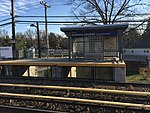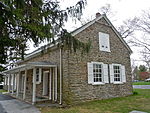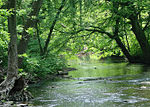Wynnewood Road station
Pages with no open date in Infobox stationPennsylvania railway station stubsSEPTA Norristown High Speed Line stationsSEPTA stubs

Wynnewood Road station is a SEPTA rapid transit station in Haverford Township, Pennsylvania. It serves the Norristown High Speed Line (Route 100) and is located at Eagle and Haverford Roads. Both local trains and Hughes Park Express trains stop at Wynnewood Road. The station lies 3.1 track miles from 69th Street Terminal. The station has off-street parking and an accessible platform.
Excerpt from the Wikipedia article Wynnewood Road station (License: CC BY-SA 3.0, Authors, Images).Wynnewood Road station
East Eagle Road, Haverford Township
Geographical coordinates (GPS) Address Nearby Places Show on map
Geographical coordinates (GPS)
| Latitude | Longitude |
|---|---|
| N 39.9933 ° | E -75.2984 ° |
Address
Wynnewood Road
East Eagle Road
19003 Haverford Township
Pennsylvania, United States
Open on Google Maps










